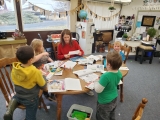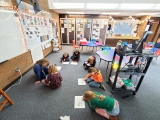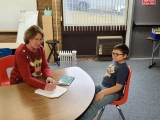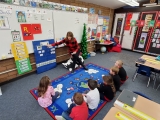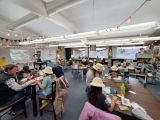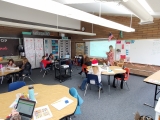-
Category 1
Selected in 2022
-
Grades: pre k - 12
School Setting: rural
Town Population: 310
Student Enrollment: 42
Student Demographics:
Black/African American: 3%
Teacher/Student Ratio: 1:6
White/Caucasian: 90.9%
Hispanic: 0%
Hawaiian/Pacific Islander: 0%
Asian: 0%
Native American: 6.1%
Other: 0%
% Reduced Lunch: 60%
% ELL Learners: 0%
Founded: 1900 -
PRINCIPAL:
Jordan Jennings -
CONTACT:
111 Hill Ave
LaCrosse, WA 99143
509-549-3591
jjennings@lacrossesd.k12.wa.us
LaCrosse Elementary School
LaCrosse, WA
"We will prepare all students to become responsible citizens, reach their full potential, and compete successfully in a changing, challenging, and diverse world."
- 1. Tell us about your school’s success.
- Our school's success came from a variety of different ideas/solutions, but the main theme for our success was the personalization of education for each of our students. Our mission statement is "In partnership with families, youth, and community, we will prepare all students to become responsible citizens, reach their full potential, and compete successfully in a changing, challenging, and diverse world." With our small class sizes, we can take a deep look at each student in terms of background, assessment data, mental health status, and special needs/accommodations, to create individualized plans for each student that addresses the whole student. Once we fully embraced our mission and realized the opportunities with class sizes, we were able to have positive and effective collaborations to implement new programs of support and evaluate why we do the things we do in terms of student success. This determination has paid off, as we are starting to see big jumps in student growth.
- 2. Talk about the greatest contributing factor(s) that promoted positive change in your school.
- The greatest contributing factor to positive change was the embracement of our school culture centered on universal student achievement. Three years ago, we had all the pieces in place to make positive changes in our school and students. What was missing was the laser-like focus on our mission and culture, and filtering everything that distracted us from those. We were able to accomplish this by setting meeting norms at staff meetings, having tough conversations around our mission/culture, setting up a leadership team with diverse representation, having transparent conversations with our community and parents, and utilizing our outside resources. By focusing on culture, the positive effects observed have included: more students receiving the special services they need, staff willing to be trained in current best practices, and community buy-in to our mission. Without this greatest factor, the other contributing factors would have never been possible.
- 3. How has ESEA funding supported the school's success?
- ESEA funding has helped support our school's success by strengthening our student programs. The programs that will be positively affected by the funding will include our after-school program, summer school program, additional staffing for one-on-one help, and student support services.
- 4. What professional development activities were used to improve teaching and learning?
- Our professional development is always based on our mission and our yearly vision statement. Last school year (2021-2022) our vision statement was about collaboration. Thus our professional development focused on cross-grade level collaborations and cross-curricular collaborations. This was vital to us because as a small school, we only have one teacher per grade level or content area. We had to develop a system where a 3rd-grade teacher could collaborate with the Kindergarten teacher. This school year (2022-2023) our vision statement is, "We provide students with a variety of instructional approaches which support their methods of learning." Thus our professional development has been based on differentiated learning, individualized educational plans, and teaching special education and highly capable students.
- 5. Talk about the cultural shift leading up to your school's success.
- We had all the pieces to be successful a couple of school years ago; however, our current success can be credited to our cultural shift. One of the challenges we had to get over was the "Every teacher for themselves," mentality. This was difficult in a small school where you have one teacher per grade level. To conquer this challenge, we grounded ourselves in the mission statement of our school and realized that we are a team. Every student in our school that stays in our district, stays on the same campus grades from preschool to 12th grade. So we shifted to student-focused needs collaboration, and had conversations based on what a student has done or been through in the past, and where they might need extra support. This culture shift is evident when staff members can greet students by name, and ask how they are doing without that student being in their class. We now have a, "It takes a village" mindset, and students constantly have positive adult interactions.
- 6. How has community involvement strengthened your success?
- As a school, our philosophy is always to communicate with and involve the community as transparently as possible. Sharing our successes and challenges with the community has been vital to our success. When we were hit with the COVID challenges just like other schools were, we did community involvement over Zoom as best as possible. We also sent communications out saying when and how the community could be involved albeit with the COVID restrictions. Once the restrictions were loosened, our numbers of attendance at things such as teacher conferences, music concerts, and other school events skyrocketed. It reaffirmed that our transparency and our willingness to communicate through the challenges was the right decision. Now we have parents coming in to help out at the school, our local church also volunteers at the school, and town committees are involved at the school.
Stats
-
Category 1
Selected in 2022
-
Grades: pre k - 12
School Setting: rural
Town Population: 310
Student Enrollment: 42
Student Demographics:
Black/African American: 3%
Teacher/Student Ratio: 1:6
White/Caucasian: 90.9%
Hispanic: 0%
Hawaiian/Pacific Islander: 0%
Asian: 0%
Native American: 6.1%
Other: 0%
% Reduced Lunch: 60%
% ELL Learners: 0%
Founded: 1900 -
PRINCIPAL:
Jordan Jennings -
CONTACT:
111 Hill Ave
LaCrosse, WA 99143
509-549-3591
jjennings@lacrossesd.k12.wa.us



